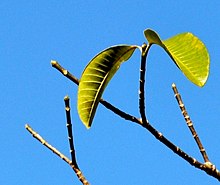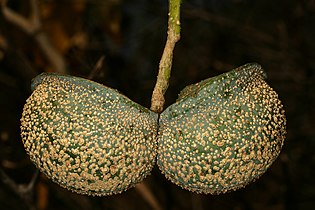Tabernaemontana elegans
| Toad tree | |
|---|---|

| |

| |
| Habit and the opposite, entire leaves in Limpopo, South Africa | |
| Scientific classification | |
| Kingdom: | Plantae |
| Clade: | Tracheophytes |
| Clade: | Angiosperms |
| Clade: | Eudicots |
| Clade: | Asterids |
| Order: | Gentianales |
| Family: | Apocynaceae |
| Genus: | Tabernaemontana |
| Species: | T. elegans
|
| Binomial name | |
| Tabernaemontana elegans | |
| Synonyms[2] | |
| |
Tabernaemontana elegans, the toad tree,[3] is a shrub or small tree in the family Apocynaceae. It is native to eastern Africa.
Description
Tabernaemontana elegans grows up to 15 metres (50 ft) tall, with a trunk diameter of up to 30 centimetres (12 in). Its fragrant flowers feature white, creamy or pale yellow
Distribution and habitat
Tabernaemontana elegans grows in forests or bushland from sea level to 1,000 metres (3,300 ft) altitude. The species is native to Somalia, Kenya, Tanzania, Mozambique, Zimbabwe, Eswatini and South Africa.[4][5][6]
Uses
Tabernaemontana elegans has some local medicinal uses including the treatment of heart disease, cancer, tuberculosis and venereal diseases. The species is also used as an aphrodisiac.[4] The Zulu name for this genus, iNomfi, refers to the use of their sticky, milky latex as bird-lime.[7]
Chemistry
Fourteen indole alkaloids have been isolated in the callus culture of Tabernaemontana elegans (isovoacangine, 3-R/S-hydroxy-isovoacangine, 3-R/S-hydroxy-coronaridine, isositsirikine, geissoschizol, tabernaemontanine, vobasine, vobasinol, apparicine, 16-hydroxy-16,22-dihydro-apparicine, tubotaiwine, 3-R/S-hydroxy-conodurine and monogagaine) of which apparicine is the principal.[8]
-
Milky latex
-
Inflorescence
-
Flower
-
Warty, symmetrical fruit
-
Visible seeds in dehisced fruit
References
- . Retrieved 20 November 2021.
- ^ a b "Tabernaemontana elegans". World Checklist of Selected Plant Families (WCSP). Royal Botanic Gardens, Kew. Retrieved 20 January 2020.
- ^ "Tabernaemontana elegans". Germplasm Resources Information Network. Agricultural Research Service, United States Department of Agriculture. Retrieved 20 January 2020.
- ^ ISBN 978-9-05782-204-9.
- ^ "Tabernaemontana elegans". Flora of Zimbabwe. Retrieved 4 August 2013.
- ^ "Tabernaemontana elegans". Encyclopedia of Life. Retrieved 4 August 2013.
- ISBN 0-620-05468-9.






